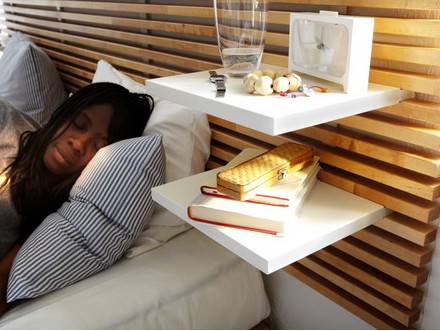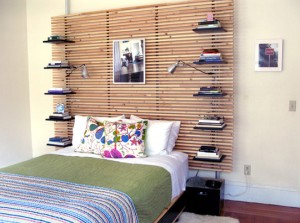Chuck the Boxer is super happy his soldier is home! Â And how nice Chuck still has his tail?!
DIY: Cat Wall
 Remember that nifty modular Catswall from last week?  I was thinking it reminded me of something I’d seen before—Ikea’s Mandal headboard. It comes with 6 shelves you can move around as you like.  Or you could get 2 headboards for even more options.  Someone over on IkeaHackers used part of a bedframe they found and some Lack shelves to make their own version.  You could make your own piece like the headboard, but for $150, I’d just get the Ikea version.
Remember that nifty modular Catswall from last week?  I was thinking it reminded me of something I’d seen before—Ikea’s Mandal headboard. It comes with 6 shelves you can move around as you like.  Or you could get 2 headboards for even more options.  Someone over on IkeaHackers used part of a bedframe they found and some Lack shelves to make their own version.  You could make your own piece like the headboard, but for $150, I’d just get the Ikea version.
I’recommend modifying the shelves by attaching sisal, sea grass, or carpet so your kitties have traction. Â I’m thinking hot glue would be the best way to do this since it might be hard to get staples or tacks through the melamine on the shelves without cracking it. Â I love this idea and just might put one up in our guest room. Â Too cool!
Friday Fun: Cat Tricks, Bouncy Yorkie, Great Slide
Moogly the Bengal cat shows off his mad skilz. Â Clicker training rawks!
Must. See. Hamster.
Very patient Great Dane. Â Very cute Basenji.
Snow Nose!
Last week I noticed that the end of Saffron’s nose looked lighter.  It’s normally black, but there was this lighter, pinker area in the middle.  Being a worrier, I started researching it and it turns out it’s something called Snow Nose or Winter Nose.  I went looking for a clear explanation of Snow Nose, but was unable to find an authoritative source.  So I started looking for a good explanation of melanogenisis (the production of melanin or pigment in tissue.)  But to understand that, I needed to understand tyrosinase (an enzyme that regulates melanogenisis).  Guess what I learned?!  Melanogenisis and tyrosinase is some seriously complicated shit! (Be sure to scroll & scroll & scroll down if you want to learn more.)
So what’s the skinny on Snow Nose?  It’s a harmless, seasonal lightening of the pigmentation of the rhinarium in dogs. (The rhinarium is the moist, hairless part at the end of a dog’s snout.)  Pigmentation is increased with exposure to ultraviolet light, increased temperatures, and friction, so the short cold days of winter cause the pigment to fade, but when summer comes, the longer days and warmer temperatures cause the pigment to darken again.
If your dog’s nose doesn’t darken again in the summer, visit your vet to see if anything is amiss. Â And there are other reasons a dog’s nose color can change, so if your dog’s nose loses all it’s pigment, has any crust or scabs, looks like it itches or hurts, or has any swelling, get your pup checked out by a vet.
Friday Fun: Ripley Romping
There’s something so fun about watching a gigantic dog playing. Â Ripley the Great Dane is a hoot!


